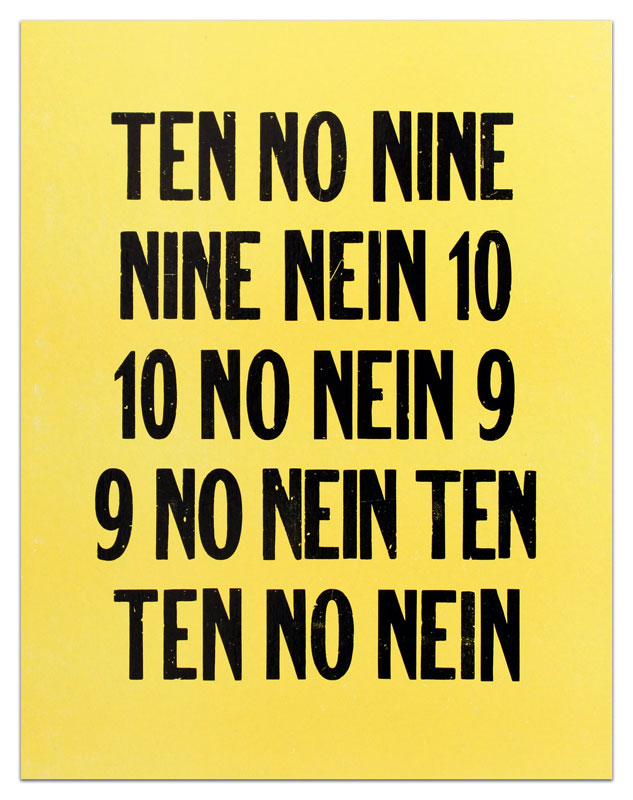Edition of 120
Signed, dated and numbered on verso
16 1/2 x 12 3/4 inches
(41.9 x 32.4 cm)
(Inventory #28769)
9/10, 1993/2004:
The original idea began in 1993. DU Magazine project,1993 (see text below); wall painting, “Korrespondenzen/ Correspondences,” 1994-5; Goethe Institut Newsletter cover, 1995; stairwell wall painting 18’10″x 10’9″, “Kay Rosen: Lifeli[k]e”; wall painting Dunedin Public Art Gallery “Kay Rosen: Big Talk”, 2004; wall painting “numerica”- palazzo delle papesse centro arte contempoanea, Siena, 2007. The following text accompanied the image in DU Magazine:
Lesson 1 began with the work’s intention of discovering and analyzing new visual and linguistic systems in brief verbal fragments. Because every mark that is made on a page creates meaning, shorter constructions generally provide stricter and more rigorous limits and controls on interpretation than do longer ones. This last lesson offers a very literal scenario on the polemics of size. The dispute concerns quantity– the sum of letters/numbers per line, nine or ten, which is indicated by the final number expressed on that line. For example, N-I-N-E-N-E-I-N-1-0 does indeed contain ten figures. Each line attempts to be specific, clear, and correct in its proceedure and solution, enlisting a variety of strateges, such as reiteration, translation, and enumeration to make its case. But in spite of their insistence, the voice or voices contradict themselves and each other. Their disagreement is a consequence of expression. The subtraction or addition of each unit of meaning, each letter or number, increases or decreases the length of the argument and thus, the conclusion. Lesson 8 is a farcical and elaborate conceit about the behavior of language and its inability to be absolute, certain, and consistent. Moreover, it demonstrates how critical the smallest components are to this behavior.

Edition of 120
Signed, dated and numbered on verso
16 1/2 x 12 3/4 inches
(41.9 x 32.4 cm)
(Inventory #28769)
9/10, 1993/2004:
The original idea began in 1993. DU Magazine project,1993 (see text below); wall painting, “Korrespondenzen/ Correspondences,” 1994-5; Goethe Institut Newsletter cover, 1995; stairwell wall painting 18’10″x 10’9″, “Kay Rosen: Lifeli[k]e”; wall painting Dunedin Public Art Gallery “Kay Rosen: Big Talk”, 2004; wall painting “numerica”- palazzo delle papesse centro arte contempoanea, Siena, 2007. The following text accompanied the image in DU Magazine:
Lesson 1 began with the work’s intention of discovering and analyzing new visual and linguistic systems in brief verbal fragments. Because every mark that is made on a page creates meaning, shorter constructions generally provide stricter and more rigorous limits and controls on interpretation than do longer ones. This last lesson offers a very literal scenario on the polemics of size. The dispute concerns quantity– the sum of letters/numbers per line, nine or ten, which is indicated by the final number expressed on that line. For example, N-I-N-E-N-E-I-N-1-0 does indeed contain ten figures. Each line attempts to be specific, clear, and correct in its proceedure and solution, enlisting a variety of strateges, such as reiteration, translation, and enumeration to make its case. But in spite of their insistence, the voice or voices contradict themselves and each other. Their disagreement is a consequence of expression. The subtraction or addition of each unit of meaning, each letter or number, increases or decreases the length of the argument and thus, the conclusion. Lesson 8 is a farcical and elaborate conceit about the behavior of language and its inability to be absolute, certain, and consistent. Moreover, it demonstrates how critical the smallest components are to this behavior.
Kay Rosen’s investigation into the visual possibilities of language has been her primary focus since 1968, when she traded in the academic study of languages for the study of language-based art. Through paintings, drawings, murals, prints, collages, and videos, Rosen has sought to generate new meaning from everyday words and phrases by substituting scale, color, materials, composition, graphic design, and typography for the printed page.
While political issues often form the bedrock of Rosen’s artwork, she insists that her work is driven not by politics, but by language, and she follows it to whatever place it takes her. Rosen loves the physical act of drawing and painting, and materially her paintings and drawings are intensively rendered; however, she considers language to be found material, conceptually placing her in the more passive role of a cognitive observer and enabler of language. The writer Rhonda Lieberman described her as a revealer of language who “shows it doing things that are totally above, beyond, and/or below its function as a mode of communication.”
Rosen’s work has been described as sculpture, poetry, architecture, and performance. Roberta Smith once called her a “writer’s sculptor” and Eileen Myles called her the “poet of the art world.” In a 2014 piece for Art In America, Rosen wrote: “The linguist in me wanted meaning to be carried by the structure of the words, not type style; the inner painter insisted that color convey meaning; the sculptor in me obsessed about the construction of letterforms through materials and process; and any poetic instincts strove for efficiency.”
Kay Rosen has been the subject of numerous articles, reviews, and group and solo exhibitions, including in 1998 a two-venue mid-career survey entitled Kay Rosen: Li[f]eli[k]e, curated by Connie Butler and Terry R. Myers at the Los Angeles Museum of Contemporary Art and Otis College of Art Design. She has been the recipient of awards that include a Guggenheim Foundation Fellowship in 2017 and three National Endowment for the Arts Visual Arts Grants. Her work is included in many institutional and private collections. Rosen taught at The School of the Art Institute of Chicago for twenty-four years. She was born and raised in Corpus Christi, Texas and lives in New York City and Gary, Indiana.
10 Newbury Street, Boston, Massachusetts 02116
617-262-4490 | info@krakowwitkingallery.com
The gallery is free and open to the public Tuesday – Saturday, 10am – 5:30pm
Notifications